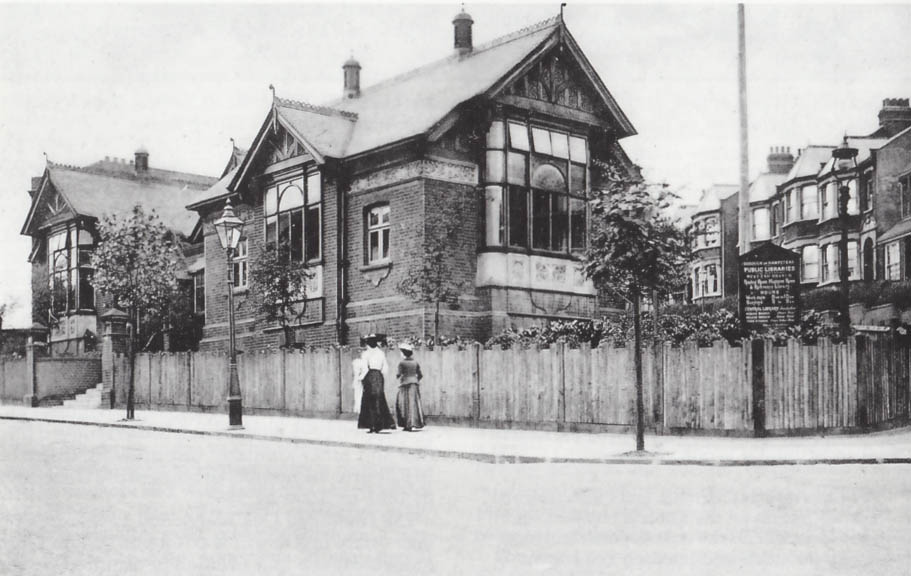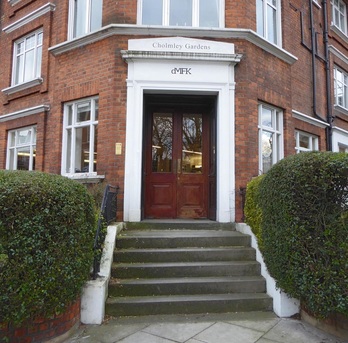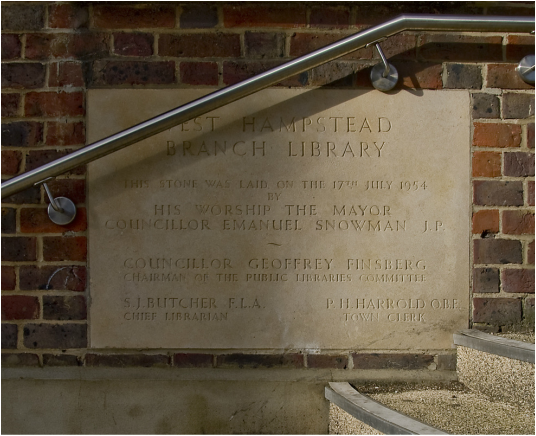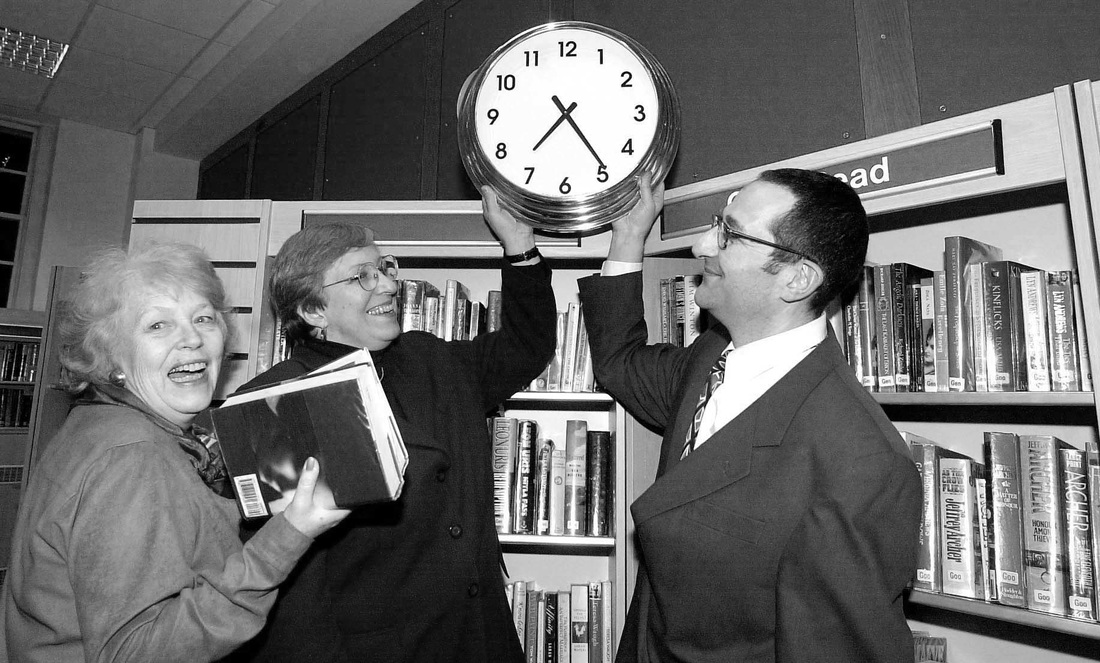HISTORY OF WEST HAMPSTEAD LIBRARY
|
West Hampstead Library has been located in its current building on the corner of West End Lane and Dennington Park Road since 1954. But book borrowing in this corner of north west London goes back long before then (writes FoWHL member Simon Inglis).
As told by local historians Dick Weindling and Marianne Colloms, the story begins at the tail end of Queen Victoria's reign, as the village of West End was becoming absorbed by the urban sprawl of the Metropolis and taking on a new identity as 'West Hampstead' (the invention, it is thought, of a canny local estate agent). The name was not a complete fabrication however. West End had indeed been the 'West End' of the parish of Hampstead for centuries. |
In 1900, when local government was re-organised in London, West Hampstead found itself part of the newly created Metropolitan Borough of Hampstead, with its administrative centre at the Town Hall on Haverstock Hill. It was thus the Mayor of Hampstead who officially opened the new West End Branch Library on February 21 1901 (a month after the death of Queen Victoria). As seen above, it was a homely building, fitting in perfectly with the recently completed terraces rising up both Westbere and Sarre Roads. Although its location may nowadays seem less central, it should be noted that another branch library had opened in 1897 on the corner of Finchley Road and Arkwright Road – the building that since 1965 has served as the Camden Arts Centre.
Unfortunately we know very little about the West End library because most of the records were lost when it was struck by an incendiary bomb on September 26 1940. A resident in a neighbouring house, 26 Sarre Road, was killed in that incident.
(Coincidentally the library on Finchley Road also sustained bomb damage; first in October 1940, killing a female air raid warden, then again at the tail end of the war in May 1945, when the building was struck by a V2 rocket.)
Unfortunately we know very little about the West End library because most of the records were lost when it was struck by an incendiary bomb on September 26 1940. A resident in a neighbouring house, 26 Sarre Road, was killed in that incident.
(Coincidentally the library on Finchley Road also sustained bomb damage; first in October 1940, killing a female air raid warden, then again at the tail end of the war in May 1945, when the building was struck by a V2 rocket.)
|
In late 1940, temporary accommodation for West Hampstead's library was provided in a semi-basement room belonging to the Methodist Church on Mill Lane (where a block of modern flats now stands on the corner of Solent Road).
This sufficed until, in November 1945, just after the end of the Second World War, Hampstead Borough Council took out a lease on the ground floor flat at 119 Cholmley Gardens (a corner of the mansion flats which dates from c.1927 and had, before the war, served as a Lloyd's Bank). This explains why the premises, now occupied by DMFK Architects, is called 'The Old Library'. Meanwhile, where the current library now stands there was a row of terraced houses dating from the 1880s, with shops on the ground floor, similar to those still seen along West End Lane. At number 263 West End Lane, on the corner of Dennington Park Road, there was a butcher's shop. On February 25 1944, in one of the flats above, a family and their friends had gathered to celebrate the marriage of one of the sons. |
Despite an air raid warning everyone stayed put in the flat, so that when a bomb struck at ten past one in the morning they stood little chance. Tragically, ten of the eleven inviduals at the party were killed, including the bride and groom, and two toddlers. Only the father of the bridegroom survived, apparently because he had nipped out to use the outside loo.
In March 1946 the War Damage Commission erected a temporary hut on the bomb site, from which officials oversaw the allocation of housing in the immediate area for dispossessed families and returning serviceman. Then, as the economy recovered and more building materials became available, construction of the new library, with flats above – Dennington Park Mansions – commenced in 1954, just as rationing finally came to an end. Other council-built flats from this post war era include Sidney Boyd Court on West End Lane, and Walter Northcott House on Fortune Green Road.
In March 1946 the War Damage Commission erected a temporary hut on the bomb site, from which officials oversaw the allocation of housing in the immediate area for dispossessed families and returning serviceman. Then, as the economy recovered and more building materials became available, construction of the new library, with flats above – Dennington Park Mansions – commenced in 1954, just as rationing finally came to an end. Other council-built flats from this post war era include Sidney Boyd Court on West End Lane, and Walter Northcott House on Fortune Green Road.
|
Local residents might also be familiar with Snowman House, a 1960s block of council flats on Abbey Road. This was named after Emanuel Snowman, the Mayor of Hampstead, whose name appears on the library foundation stone (right), laid on July 17 1954.
Another name on the foundation stone that will be familiar to older residents is that of Geoffrey Finsberg, then chairman of the Public Libraries Committee and subsequently the Conservative MP for Hampstead (later Hampstead and Highgate) from 1970 to 1992. If anyone can tell us more about Messrs Butcher (the Chief Librarian) and Harrold (the Town Clerk) we would be delighted to learn more. |
If you look up above the entrance to the library you will see another reference to the Borough of Hampstead – its coat of arms, bearing the motto, Non Sibi Sed Toti – 'not for self but for all' – a fine sentiment that perfectly encapsulates the spirit of public service and public libraries.
In 1965, further reorganisation of local government in London led to the merger of the boroughs of Hampstead, Holborn and St Pancras to form the London Borough of Camden. In total, 17 libraries came under the jurisdiction of this new entity, serving a population of approximately 220,000.
As far as can be ascertained, the first real threats to services at West Hampstead Library surfaced in 1998, a time when councils all over Britain were starting to cut back or to contract out public services under the policy of Compulsory Competitive Tendering. By this time the total number of libraries in Camden had fallen to fourteen (including a mobile library), so that when plans were announced to close several more (but without identifying which), local residents sprang into action. At that time there were only two Friends group in existence (at Belsize Park and Heath, both of which had been threatened with closure). Representatives from other libraries then formed a borough-wide campaign group, the Camden Public Libraries Users' group (CPLUG), followed later on in 1998 by the formation of FoWHL at a packed meeting in West Hampstead Library.
Realising the strength of public opinion, and that closing libraries would cost them votes, councillors threw out the proposed library strategy and set up an all-party committee with an independent chair, Tony Travers of the London School of Economics. This committee's recommendations – for greater transparency and consultation with the public, and no immediate closures – set the tone for library policy for the next decade. Indeed it helped to bring about major improvements at West Hampstead, where instead of closure, some £250,000 was spent by Camden during 2000-01 on a major refurbishment of the library interior. This included the installation of a lift to link the basement children's library with the ground floor, the replacement of the library shelves, new furniture, suspended ceilings and lighting.
This was also a golden era for FoWHL, with regular events – click here for some examples – a membership topping 500, and the support of local authors Doris Lessing, Stephen Fry and Anna Raeburn.
In 1965, further reorganisation of local government in London led to the merger of the boroughs of Hampstead, Holborn and St Pancras to form the London Borough of Camden. In total, 17 libraries came under the jurisdiction of this new entity, serving a population of approximately 220,000.
As far as can be ascertained, the first real threats to services at West Hampstead Library surfaced in 1998, a time when councils all over Britain were starting to cut back or to contract out public services under the policy of Compulsory Competitive Tendering. By this time the total number of libraries in Camden had fallen to fourteen (including a mobile library), so that when plans were announced to close several more (but without identifying which), local residents sprang into action. At that time there were only two Friends group in existence (at Belsize Park and Heath, both of which had been threatened with closure). Representatives from other libraries then formed a borough-wide campaign group, the Camden Public Libraries Users' group (CPLUG), followed later on in 1998 by the formation of FoWHL at a packed meeting in West Hampstead Library.
Realising the strength of public opinion, and that closing libraries would cost them votes, councillors threw out the proposed library strategy and set up an all-party committee with an independent chair, Tony Travers of the London School of Economics. This committee's recommendations – for greater transparency and consultation with the public, and no immediate closures – set the tone for library policy for the next decade. Indeed it helped to bring about major improvements at West Hampstead, where instead of closure, some £250,000 was spent by Camden during 2000-01 on a major refurbishment of the library interior. This included the installation of a lift to link the basement children's library with the ground floor, the replacement of the library shelves, new furniture, suspended ceilings and lighting.
This was also a golden era for FoWHL, with regular events – click here for some examples – a membership topping 500, and the support of local authors Doris Lessing, Stephen Fry and Anna Raeburn.
It fell first on three fixed libraries: at Belsize, Chalk Farm and Heath. Each of these was then taken over by the Friends' groups, and turned into volunteer-run libraries, a model that was by then becoming increasingly common (and which found great favour amongst those preaching the benefits of 'the Big Society'). A fourth library, at Regent's Park, was then closed altogether in April 2013. Added to this was the closure of the Mobile Library in April 2012. Another victim was Kilburn Library, on Cotleigh Road, although this was replaced by a modern building on Kilburn High Road (in a controversial location, right on Camden's borders with Westminster and Brent).
Thus just nine libraries remained in the borough, despite the population being around the same figure of 220,000 as it had been in 1965 (according to the 2011 Census), when there had been 17 libraries.
West Hampstead appeared to escape relatively lightly during that particular round of cuts. Indeed in the spring of 2012 another substantial sum was spent on refurbishing the outside of the library, with new steps leading up to the front door, a new ramp and new signage. The costs were met by a cash allocation provided by Camden Council to West Hampstead specifically for works chosen by local residents. That they chose to devote this allocation to the library was yet another demonstration – one of many over the years – of just how highly the people of West Hampstead value its services.
But for all the improvements, behind the scenes the cuts continued; to opening hours, staffing levels and to book stocks, until once again the pressure told and yet another serious threat emerged during the summer of 2015. This was shortly after the General Election, when Camden announced that in the wake of the Conservative government's cuts to local authority funding, it needed to make cuts of its own, amounting to a massive £80 million of its overall budget, including £800,000 to its library expenditure. Once again rumours circulated that West Hampstead could be one of seven libraries either to close or to have its services severely reduced.
There then followed a further round of consultation between July and October 2015, in which over 2,000 people participated. An impressive 29 per cent of all respondents, incidentally, identified themselves of users of West Hampstead (second only to the response from Swiss Cottage users), even though in terms of its number of visitors (around 86,000 per year) West Hampstead is one of the smaller Camden libraries still operating. Amongst the under 16s who participated, 19 per cent were regulars at West Hampstead.
Fortunately, it appears that as a result of Camden's deliberations in early 2016, West Hampstead Library is safe for the time being. But make no mistake, unless there is a U turn by the Conservative government over its austerity measures and a change of heart by Camden, almost inevitably serious cuts lie ahead, and with them, increasing pressure on the library service to find ways of maximising the library's assets, at the expense of books. For example one idea aired by local Labour party representatives in early 2016 was the conversion of the children's library into a doctors' surgery.
All the more reason therefore to keep on supporting the Friends of West Hampstead Library. But more importantly than that, to support the library itself.
Use it lose it. That must be our motto for the coming years!
For more recent news of West Hampstead Library and FoWHL events see our News page.
Thus just nine libraries remained in the borough, despite the population being around the same figure of 220,000 as it had been in 1965 (according to the 2011 Census), when there had been 17 libraries.
West Hampstead appeared to escape relatively lightly during that particular round of cuts. Indeed in the spring of 2012 another substantial sum was spent on refurbishing the outside of the library, with new steps leading up to the front door, a new ramp and new signage. The costs were met by a cash allocation provided by Camden Council to West Hampstead specifically for works chosen by local residents. That they chose to devote this allocation to the library was yet another demonstration – one of many over the years – of just how highly the people of West Hampstead value its services.
But for all the improvements, behind the scenes the cuts continued; to opening hours, staffing levels and to book stocks, until once again the pressure told and yet another serious threat emerged during the summer of 2015. This was shortly after the General Election, when Camden announced that in the wake of the Conservative government's cuts to local authority funding, it needed to make cuts of its own, amounting to a massive £80 million of its overall budget, including £800,000 to its library expenditure. Once again rumours circulated that West Hampstead could be one of seven libraries either to close or to have its services severely reduced.
There then followed a further round of consultation between July and October 2015, in which over 2,000 people participated. An impressive 29 per cent of all respondents, incidentally, identified themselves of users of West Hampstead (second only to the response from Swiss Cottage users), even though in terms of its number of visitors (around 86,000 per year) West Hampstead is one of the smaller Camden libraries still operating. Amongst the under 16s who participated, 19 per cent were regulars at West Hampstead.
Fortunately, it appears that as a result of Camden's deliberations in early 2016, West Hampstead Library is safe for the time being. But make no mistake, unless there is a U turn by the Conservative government over its austerity measures and a change of heart by Camden, almost inevitably serious cuts lie ahead, and with them, increasing pressure on the library service to find ways of maximising the library's assets, at the expense of books. For example one idea aired by local Labour party representatives in early 2016 was the conversion of the children's library into a doctors' surgery.
All the more reason therefore to keep on supporting the Friends of West Hampstead Library. But more importantly than that, to support the library itself.
Use it lose it. That must be our motto for the coming years!
For more recent news of West Hampstead Library and FoWHL events see our News page.
FURTHER READING on the HISTORY of WEST HAMPSTEAD
The following books and articles about the history of West Hampstead are available either from the library or from the Camden Local Studies and Archives Centre in Holborn. Note that some of these publications are available only for reference, not for loan. Please refer to the Camden Library's Catalogue for more details.
A Brief History of West Hampstead Community Association, by Virginia Berridge (WHCA, 1997)
A Child's Eye View of West Hampstead, by Caroline Woollett (1995)
Block in a landscape: Alexandra Mansions in West Hampstead 1860-1960, by Michael Redley (Alexandra Mansions, 1992)
Bloody British History: Camden by Marianne Colloms & Dick Weindling (History Press, 2013)
Brief history of the Mill Lane Gardening Project, West Hampstead, in London: a Guide to Recent Architecture (Batsford, 2002)
Decca Studios and Klooks Kleek: West Hampstead's musical heritage remembered,
by Dick Weindling & Marianne Colloms (History Press, 2013)
Emmanuel Church, West End Hampstead: a Complete History, by Jennifer Tucker (1981)
Fairhazel: Where the Bombs Fell - Reminiscences by the Scanlon family about air raids in West Hampstead during WW2,
by Louise Reid (Fairhazel Housing Co-operative newsletter, no.96, May 1994)
Growing up in Edwardian West Hampstead: a personal account, by Warwick Edwards (no date)
Hampstead at War, 939-1945, by Christopher Wade (Camden History Society, 1995)
Wartime Camden, Life in Camden during the First and Second World Wars, compiled by Hart, V. & Marhsall, L, pub. London Borough of Camden, 1983
Hampstead - the Building of a Borough 1650-1964, by FML Thompson (1974)
Kilburn and West Hampstead Past, by Dick Weindling & Marianne Colloms (Historial Publications, 1999)
Notes on Charles Taylor (1897-1993) and his connections with Emmanuel Church, West Hampstead, by Robert Taylor (1993)
Place names and shop names: West End, West Hampstead and Hampstead West, and the shops on West End Lane
by Jeremy Coote ((Journal of the Anthropological Society of Oxford, Vol 19, No 2, Trinity 1988)
Records of the Manor, Parish and Borough of Hampstead, by Frederick E Baines (1890)
The Annals of Hampstead, Vols 1-3, by Thomas J Barratt (1912)
The Artists of West Hampstead Studios [Sherriff Road], by Dick Weindling & Marianne Colloms
(Camden History Review 31, 2007)
The Beggars of West Hampstead, by D Lindsay (Camden History Review 6, 1978)
The End of the Cock and Hoop [the pub which overlooked West End Green], by M Redley (Camden History Review 9, 1981)
The Fight for Fortune Green, by Dick Weindling (Camden History Review 10, 1982)
The Good Grave Guide to Hampstead Cemetery, by Marianne Colloms & Dick Weindling (Camden History Society, 2000)
The History of Hampstead Synagogue 1892-1967, by Raymond Apple (1967)
The School in Mill Lane: the history of Emmanuel Primary School, West Hampstead, 1845-1972, by Trevor Jennings (1972)
The Parish Church of West End Hampstead: a short history and guide, by J Tucker (1981)
The Streets of West Hampstead, by Christopher Wade (Camden History Society, 1992)
The Topography and Natural History of Hampstead, by John J Park (1914)
West End House and the Beckford Scandal, by Dick Weindling (Camden History Review 20, 1996)
West Hampstead's Railway Invasion, by Michael Alpert (Camden History Review 7, 1979)
West Hampstead Fire Station: 100 years of heroism, by Catherine Etoe (Camden New Journal souvenir edition, June 24 2001)
West Hampstead Guide, by Charles J Munich (Hampstead Tradesman's Association (1912)
William A Scott, 1871-1921: architect of West Hampstead Fire Station, 1901, in London, Exploring England's Heritage, by Elain Harwood & Andrew Saint (1991)
A Brief History of West Hampstead Community Association, by Virginia Berridge (WHCA, 1997)
A Child's Eye View of West Hampstead, by Caroline Woollett (1995)
Block in a landscape: Alexandra Mansions in West Hampstead 1860-1960, by Michael Redley (Alexandra Mansions, 1992)
Bloody British History: Camden by Marianne Colloms & Dick Weindling (History Press, 2013)
Brief history of the Mill Lane Gardening Project, West Hampstead, in London: a Guide to Recent Architecture (Batsford, 2002)
Decca Studios and Klooks Kleek: West Hampstead's musical heritage remembered,
by Dick Weindling & Marianne Colloms (History Press, 2013)
Emmanuel Church, West End Hampstead: a Complete History, by Jennifer Tucker (1981)
Fairhazel: Where the Bombs Fell - Reminiscences by the Scanlon family about air raids in West Hampstead during WW2,
by Louise Reid (Fairhazel Housing Co-operative newsletter, no.96, May 1994)
Growing up in Edwardian West Hampstead: a personal account, by Warwick Edwards (no date)
Hampstead at War, 939-1945, by Christopher Wade (Camden History Society, 1995)
Wartime Camden, Life in Camden during the First and Second World Wars, compiled by Hart, V. & Marhsall, L, pub. London Borough of Camden, 1983
Hampstead - the Building of a Borough 1650-1964, by FML Thompson (1974)
Kilburn and West Hampstead Past, by Dick Weindling & Marianne Colloms (Historial Publications, 1999)
Notes on Charles Taylor (1897-1993) and his connections with Emmanuel Church, West Hampstead, by Robert Taylor (1993)
Place names and shop names: West End, West Hampstead and Hampstead West, and the shops on West End Lane
by Jeremy Coote ((Journal of the Anthropological Society of Oxford, Vol 19, No 2, Trinity 1988)
Records of the Manor, Parish and Borough of Hampstead, by Frederick E Baines (1890)
The Annals of Hampstead, Vols 1-3, by Thomas J Barratt (1912)
The Artists of West Hampstead Studios [Sherriff Road], by Dick Weindling & Marianne Colloms
(Camden History Review 31, 2007)
The Beggars of West Hampstead, by D Lindsay (Camden History Review 6, 1978)
The End of the Cock and Hoop [the pub which overlooked West End Green], by M Redley (Camden History Review 9, 1981)
The Fight for Fortune Green, by Dick Weindling (Camden History Review 10, 1982)
The Good Grave Guide to Hampstead Cemetery, by Marianne Colloms & Dick Weindling (Camden History Society, 2000)
The History of Hampstead Synagogue 1892-1967, by Raymond Apple (1967)
The School in Mill Lane: the history of Emmanuel Primary School, West Hampstead, 1845-1972, by Trevor Jennings (1972)
The Parish Church of West End Hampstead: a short history and guide, by J Tucker (1981)
The Streets of West Hampstead, by Christopher Wade (Camden History Society, 1992)
The Topography and Natural History of Hampstead, by John J Park (1914)
West End House and the Beckford Scandal, by Dick Weindling (Camden History Review 20, 1996)
West Hampstead's Railway Invasion, by Michael Alpert (Camden History Review 7, 1979)
West Hampstead Fire Station: 100 years of heroism, by Catherine Etoe (Camden New Journal souvenir edition, June 24 2001)
West Hampstead Guide, by Charles J Munich (Hampstead Tradesman's Association (1912)
William A Scott, 1871-1921: architect of West Hampstead Fire Station, 1901, in London, Exploring England's Heritage, by Elain Harwood & Andrew Saint (1991)





